Native Instruments Maschine 2.0 MK3 Operation Manual v2.8
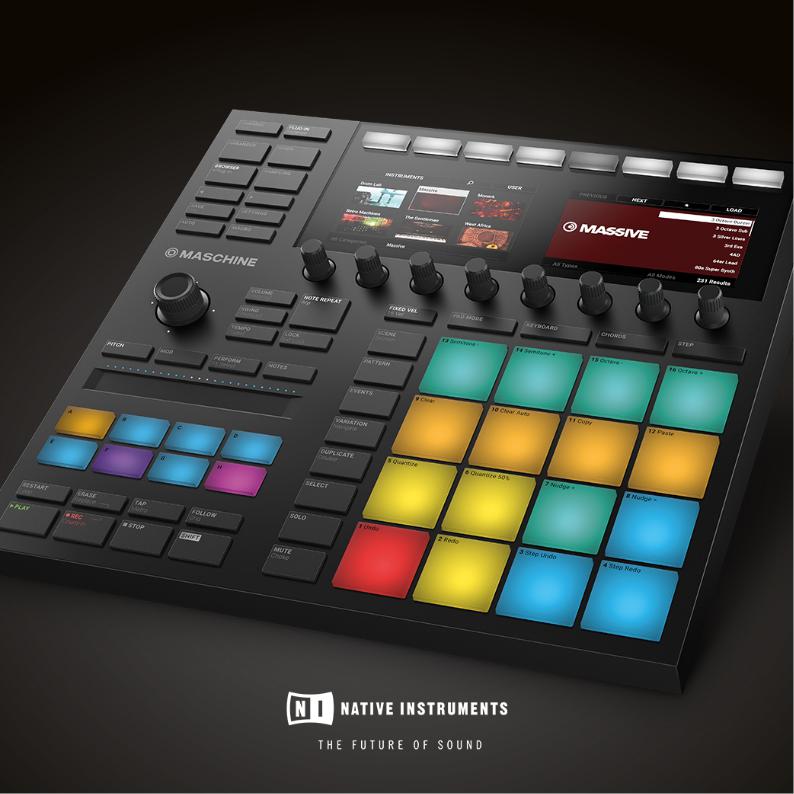
MASCHINE MK3 GETTING STARTED

Disclaimer
The information in this document is subject to change without notice and does not represent a commitment on the part of Native Instruments GmbH. The software described by this document is subject to a License Agreement and may not be copied to other media. No part of this publication may be copied, reproduced or otherwise transmitted or recorded, for any purpose, without prior written permission by Native Instruments GmbH, hereinafter referred to as Native Instruments.
“Native Instruments”, “NI” and associated logos are (registered) trademarks of Native Instruments GmbH.
ASIO, VST, HALion and Cubase are registered trademarks of Steinberg Media Technologies GmbH.
All other product and company names are trademarks™ or registered® trademarks of their respective holders. Use of them does not imply any affiliation with or endorsement by them.
Document authored by: David Gover, Nicolas Sidi Software version: 2.8 (02/2019)
Hardware version: MASCHINE MK3
Special thanks to the Beta Test Team, who were invaluable not just in tracking down bugs, but in making this a better product.

Contact
NATIVE INSTRUMENTS GmbH
Schlesische Str. 29-30 D-10997 Berlin Germany
www.native-instruments.de
NATIVE INSTRUMENTS K.K.
YO Building 3F
Jingumae 6-7-15, Shibuya-ku, Tokyo 150-0001
Japan www.native-instruments.co.jp
NATIVE INSTRUMENTS FRANCE SARL
113 Rue Saint-Maur
75011 Paris France
www.native-instruments.com
NATIVE INSTRUMENTS North America, Inc.
6725 Sunset Boulevard 5th Floor
Los Angeles, CA 90028 USA www.native-instruments.com
NATIVE INSTRUMENTS UK Limited
18 Phipp Street London EC2A 4NU UK
www.native-instruments.co.uk
SHENZHEN NATIVE INSTRUMENTS COMPANY Limited
5F, Shenzhen Zimao Center
111 Taizi Road, Nanshan District, Shenzhen, Guangdong
China www.native-instruments.com
© NATIVE INSTRUMENTS GmbH, 2019. All rights reserved.

Table of Contents
Table of Contents
1 |
Welcome to MASCHINE |
............................................................................................. |
10 |
||
|
1.1 |
Documentation Overview ............................................................................................................ |
11 |
||
|
|
1.1.1 |
In This Document ....................................................................................................... |
12 |
|
|
|
1.1.2 |
Document ..............................................................................................Conventions |
13 |
|
2 |
Setting Up MASCHINE ................................................................................................ |
|
17 |
||
|
2.1 |
Connecting the Controller .................................................................................to the Computer |
17 |
||
|
2.2 |
Basic Audio Configuration .......................................................................................................... |
18 |
||
|
|
2.2.1 |
Using Your .............................Controller as Audio Device in the MASCHINE Software |
19 |
|
|
|
2.2.2 |
Selecting ...........the MASCHINE Controller as Audio Device in Other Music Software |
21 |
|
|
|
2.2.3 |
Selecting the MASCHINE Controller as Default Audio Output Device in Your Operat- |
|
|
|
|
|
ing System ................................................................................................................. |
22 |
|
|
|
|
2.2.3.1 ............................................................................................... |
On Windows |
22 |
|
|
|
2.2.3.2 .................................................................................................. |
On macOS |
22 |
|
2.3 |
Setup Examples .......................................................................................................................... |
|
23 |
|
|
|
2.3.1 |
Connecting ..........................................................................Active Monitor Speakers |
23 |
|
|
|
2.3.2 |
Connecting ............................................................................................Headphones |
25 |
|
|
|
2.3.3 |
MASCHINE ................................................................................in a Recording Setup |
26 |
|
|
|
|
2.3.3.1 ............................................................Connecting a Dynamic Microphone |
27 |
|
|
|
|
2.3.3.2 Connecting Line Level Equipment (Synthesizer / Computer / Mixer Line |
|
|
|
|
|
........................................................................................................... |
Out) |
28 |
|
|
2.3.4 |
Connecting ...................................................................................................a Pedal |
30 |
|
|
|
2.3.5 |
Connecting ........................................................................External MIDI Equipment |
30 |
|
3 |
First Steps ................................................................................................................ |
|
|
32 |
|
|
3.1 |
Loading a Drum Kit ..............................................................................from the Factory Library |
33 |
||
|
3.2 |
Playing with the Pads ................................................................................................................. |
37 |
||
MASCHINE - Getting Started - 4

|
|
|
Table of Contents |
|
|
|
|
3.3 |
Recording Your First Pattern ....................................................................................................... |
38 |
|
3.4 |
Playing with Your Pattern ........................................................................................................... |
40 |
|
|
3.4.1 |
Using Solo and Mute .................................................................................................. |
40 |
|
3.4.2 |
Using Note Repeat ..................................................................................................... |
42 |
3.5 |
Saving Your Project .................................................................................................................... |
43 |
|
3.6 |
To Sum Up… .............................................................................................................................. |
44 |
|
4 Building Your Own Drum Kit ....................................................................................... |
46 |
||
4.1 |
Opening Your Project .................................................................................................................. |
46 |
|
4.2 |
Customizing Your Drum Kit ......................................................................................................... |
49 |
|
|
4.2.1 |
Selecting Another Snare Sample ................................................................................ |
50 |
|
4.2.2 |
Loading a Drumsynth ................................................................................................ |
53 |
|
|
4.2.2.2 Loading a Drumsynth into a Plug - in List on the Controller ........................ |
57 |
|
4.2.3 |
Adjusting Volume, Swing and Tempo ......................................................................... |
59 |
|
4.2.4 |
Changing the Color of Your Sounds ........................................................................... |
62 |
|
4.2.5 |
Moving your Sounds and Groups ................................................................................ |
64 |
4.3 |
Saving Your Project .................................................................................................................... |
65 |
|
4.4 |
To Sum Up… .............................................................................................................................. |
65 |
|
5 Creating Beats |
.......................................................................................................... |
67 |
|
5.1 |
Fine-tuning .....................................................................................................your First Pattern |
67 |
|
|
5.1.1 ...................................................................................... |
Your Pattern in the Software |
68 |
|
5.1.2 ............................................................ |
Doubling the Pattern and Adding a Variation |
69 |
|
5.1.3 .............................................................................................. |
Quantizing the Rhythm |
70 |
5.2 |
Adding a ............................................................................................................Second Pattern |
73 |
|
|
5.2.1 ............................................................................................. |
Selecting a Pattern Slot |
73 |
|
5.2.2 ..................................................................................... |
Adjusting the Pattern Length |
74 |
|
5.2.3 ............................................................ |
Recording a New Pattern Using the Count - in |
76 |
MASCHINE - Getting Started - 5

|
|
|
Table of Contents |
|
|
|
|
|
5.2.4 |
Switching Patterns .................................................................................................... |
76 |
5.3 |
Editing Patterns in the Software ................................................................................................. |
77 |
|
5.4 |
Saving Your Project .................................................................................................................... |
78 |
|
5.5 |
To Sum Up… .............................................................................................................................. |
79 |
|
6 Adding a Bass Line .................................................................................................... |
80 |
||
6.1 |
Selecting Another Group ............................................................................................................. |
81 |
|
6.2 |
Renaming and Coloring the Group .............................................................................................. |
83 |
|
6.3 |
Using an Instrument Plug-in for the Bass .................................................................................. |
84 |
|
|
6.3.1 |
Browsing the MASSIVE Presets .................................................................................. |
85 |
|
6.3.2 |
Switching to Keyboard Mode ...................................................................................... |
89 |
|
6.3.3 |
Adjusting the Root Note for the Pads ......................................................................... |
91 |
6.4 |
Recording a Bass Line ................................................................................................................ |
93 |
|
|
6.4.1 |
Recording a Bass Pattern .......................................................................................... |
93 |
|
6.4.2 |
Recording Another Bass Pattern ................................................................................ |
93 |
|
6.4.3 |
Loading an Additional Bass Sound ............................................................................ |
94 |
6.5 |
Accessing the Plug-in Parameters .............................................................................................. |
95 |
|
6.6 |
Saving Your Project .................................................................................................................... |
98 |
|
6.7 |
To Sum Up… .............................................................................................................................. |
99 |
|
7 Applying Effects |
........................................................................................................ |
100 |
|
7.1 |
Loading Effects .......................................................................................................................... |
101 |
|
7.2 |
Playing with Effects .................................................................................................................... |
106 |
|
|
7.2.1 |
Adjusting the Effect Parameters ................................................................................ |
106 |
|
7.2.2 |
Practice Makes Perfect! ............................................................................................. |
108 |
|
7.2.3 |
Bypassing Effects ...................................................................................................... |
108 |
7.3 |
Modulating Effect Parameters .................................................................................................... |
110 |
|
|
7.3.1 |
Recording Modulation ................................................................................................ |
111 |
MASCHINE - Getting Started - 6

|
|
|
|
Table of Contents |
|
|
|
|
|
|
|
7.3.2 |
Editing Modulation .................................................................................................... |
113 |
|
7.4 |
Saving Your Project .................................................................................................................... |
114 |
|
|
7.5 |
To Sum Up… .............................................................................................................................. |
114 |
|
8 |
Creating Beats with the Step Sequencer ..................................................................... |
115 |
||
|
8.1 |
Building Up a Beat in Step Mode ................................................................................................ |
116 |
|
|
|
8.1.1 |
Using Step Mode ........................................................................................................ |
116 |
|
|
8.1.2 |
Adjusting the Pattern Length in Step Mode ............................................................... |
117 |
|
|
8.1.3 |
Recording Modulation in Step Mode .......................................................................... |
118 |
|
|
8.1.4 |
A Few Notes on Step Mode ......................................................................................... |
119 |
|
8.2 |
Adjusting the Step Grid .............................................................................................................. |
120 |
|
|
8.3 |
Saving Your Project .................................................................................................................... |
122 |
|
|
8.4 |
To Sum Up… .............................................................................................................................. |
123 |
|
9 |
Creating Scenes ........................................................................................................ |
124 |
||
|
9.1 |
Working with Scenes ................................................................................................................... |
124 |
|
|
9.2 |
Assigning Patterns to Scenes ..................................................................................................... |
125 |
|
|
9.3 |
Managing Scenes ....................................................................................................................... |
128 |
|
|
|
9.3.1 |
Renaming and Coloring Scene Slots .......................................................................... |
129 |
|
|
9.3.2 |
Duplicating and Deleting Scenes ............................................................................... |
129 |
|
9.4 |
To Sum Up… .............................................................................................................................. |
131 |
|
|
9.5 |
Saving Your Project .................................................................................................................... |
131 |
|
10 |
Creating an Arrangement ........................................................................................... |
133 |
||
|
10.1 |
Accessing Song view .................................................................................................................. |
133 |
|
|
|
10.1.1 |
Creating your First Section ........................................................................................ |
135 |
|
|
10.1.2 |
Assigning a Scene to a Section .................................................................................. |
136 |
|
10.2 |
Managing Sections ..................................................................................................................... |
137 |
|
|
|
10.2.1 |
Adjusting the Length of a Section .............................................................................. |
137 |
MASCHINE - Getting Started - 7

|
|
|
|
Table of Contents |
|
|
|
|
|
|
|
|
10.2.1.1 Adjusting the Length of a Section Using the Software ............................... |
138 |
|
|
|
10.2.1.2 Adjusting the Length of a Section Using the Controller ............................. |
139 |
|
|
10.2.2 |
Duplicating and Removing Sections .......................................................................... |
140 |
|
10.3 |
Selecting a Loop Range .............................................................................................................. |
142 |
|
|
10.4 |
Saving Your Project .................................................................................................................... |
|
143 |
|
10.5 |
To Sum Up… .............................................................................................................................. |
|
144 |
11 |
Playing Live |
|
145 |
|
|
11.1 |
Performing ................................................................with Scenes and Sections using the Pads |
145 |
|
12 |
Quick Reference ........................................................................................................ |
|
149 |
|
|
12.1 |
Using ..................................................................................................................Your Controller |
|
149 |
|
|
12.1.1 .......................................................................... |
Controller Modes and Mode Pinning |
149 |
|
|
12.1.2 ................................................. |
Controlling the Software Views from Your Controller |
151 |
|
12.2 |
MASCHINE ........................................................................................................Project Overview |
154 |
|
|
|
12.2.1 ........................................................................................................... |
Sound Content |
155 |
|
|
12.2.2 .............................................................................................................. |
Arrangement |
156 |
|
12.3 |
MASCHINE ...................................................................................................Hardware Overview |
159 |
|
|
|
12.3.1 .................................................................................. |
MASCHINE Hardware Overview |
159 |
|
|
.......................................................................................... |
Control Section |
161 |
|
|
............................................................................................... |
Edit Section |
164 |
|
|
.................................................................................. |
Performance Section |
165 |
|
|
............................................................................................ |
Group Section |
167 |
|
|
...................................................................................... |
Transport Section |
167 |
|
|
............................................................................................... |
Pad Section |
169 |
|
|
................................................................................................. |
Rear Panel |
174 |
|
12.4 |
MASCHINE .....................................................................................................Software Overview |
176 |
|
|
|
12.4.1 ....................................................................................................................... |
|
177 |
MASCHINE - Getting Started - 8

|
|
|
|
Table of Contents |
|
|
|
|
|
|
|
12.4.2 |
Browser ..................................................................................................................... |
179 |
|
|
12.4.3 |
Arranger .................................................................................................................... |
181 |
|
|
12.4.4 |
Control Area ............................................................................................................... |
184 |
|
|
12.4.5 |
Pattern Editor ............................................................................................................ |
185 |
13 |
Troubleshooting |
........................................................................................................ |
187 |
|
|
13.1 |
Knowledge Base ......................................................................................................................... |
187 |
|
|
13.2 |
Technical Support ....................................................................................................................... |
187 |
|
|
13.3 |
Registration Support .................................................................................................................. |
188 |
|
|
13.4 |
User Forum ................................................................................................................................. |
188 |
|
14 |
Glossary ................................................................................................................... |
|
189 |
|
|
Index |
........................................................................................................................ |
|
197 |
MASCHINE - Getting Started - 9

Welcome to MASCHINE
1Welcome to MASCHINE
Thank you for buying MASCHINE!
MASCHINE is essentially the synergy of the MASCHINE controller hardware and the MASCHINE software combining the advantages of both worlds for making music, live as well as in the studio. The intuitive, hands-on qualities of a dedicated Instrument, the MASCHINE controller, with the advanced editing features and the versatility of the MASCHINE software turn it into the creative center of your musical productions.
You can create tight rhythms, harmonies and melodies — the highly enjoyable instrument combines a pattern-based sequencer, professional sampler, multiple studio and creative effects, and VST/AU plug-in host. Everything is intuitively controllable via the fully integrated hardware — once you touch the tactile controller the fun and intuitive workflow takes over, allowing you to stay focused on your music.
Since you can integrate it in any DAW that supports VST, Audio Units or the AAX format with multiple instances, you can profit from its abilities in almost any software setup or use it as a stand-alone application. You can sample your own material, slice loops and rearrange them easily turning your ideas into full productions.
However, MASCHINE is a lot more than an ordinary drum machine or sampler: It comes with an 8-gigabyte Library programmed and created by well-known artists and a sophisticated, yet easy to use tag-based Browser to give you instant access to the sounds you are looking for. But it doesn’t stop there! You can create your own sounds and samples or use MASCHINE EXPANSION packs, available for purchase from the Native Instruments website to further enhance your library of sounds.
You can also control your external MIDI Hardware and Software with the MASCHINE controller and customize the functions of the pads, knobs and buttons to your needs, utilizing the Controller Editor Application.
We hope you enjoy the MASCHINE playground as much as we do. Now let’s get going!
MASCHINE - Getting Started - 10

Welcome to MASCHINE
Documentation Overview
1.1Documentation Overview
Native Instruments provide many information sources regarding MASCHINE. The main documents should be read in the following sequence:
1.MASCHINE Getting Started (this document): The MASCHINE Getting Started guide provides a practical approach to MASCHINE via a set of tutorials covering simple tasks in order to help you familiarize yourself with MASCHINE.
2.MASCHINE Manual: The MASCHINE Manual provides you with a comprehensive description of all MASCHINE software and hardware features.
Additional documentation sources provide you with details on more specific topics:
▪Controller Editor Manual: Besides using your MASCHINE hardware controller together with its dedicated MASCHINE software, you can also use it as a powerful and highly versatile MIDI controller to pilot any other MIDI-capable application or device. This is made possible by the Controller Editor software, an application that allows you to precisely define all MIDI assignments for your MASCHINE controller. The Controller Editor was installed during the MASCHINE installation procedure. For more information on this, please refer to the Controller Editor Manual available as a PDF file via the Help menu of Controller Editor.
▪Online Support Videos: You can find a number of support videos on The Official Native Instruments Support Channel under the following URL: https://www.youtube.com/NIsupportEN. We recommend that you follow along with these instructions while the respective application is running on your computer.
Other Online Resources: If you are experiencing problems related to your Native Instruments product that the supplied documentation does not cover, there are several ways of getting help:
▪Knowledge Base
▪User Forum
▪Technical Support
▪Registration Support
You will find more information on these subjects in the chapter ↑13, Troubleshooting.
MASCHINE - Getting Started - 11
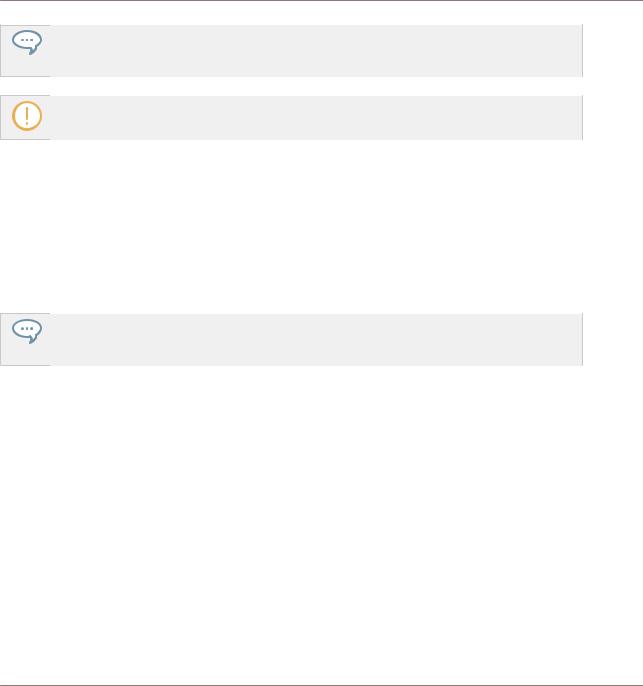
Welcome to MASCHINE
Documentation Overview
MASCHINE documents are available in PDF. You can also access these documents from the application’s Help menu or the following location:
www.native-instruments.com.
Please check the Native Instruments website regularly for up-to-date and localized versions of these documents.
1.1.1In This Document
What you are reading now is the MASCHINE Getting Started. This document consists of a set of tutorials that will guide you through common workflows in MASCHINE. Please follow these tutorials in the described order. You will learn a little something in each of them which will be essential later on. On the way, you will get to know the main objects and concepts of MASCHINE. After reading this, you should have the basic know-how allowing you to make music with MASCHINE!
Even if you’re already familiar with MASCHINE, all tutorials are worth a read as every chapter may have little workflow hints of which you weren’t aware. Should you wish to revise a specific task covered in a later tutorial, be sure to check the prerequisites listed at the beginning of each chapter!
This document is structured as follows:
▪The first part includes this introduction and the following chapter ↑2, Setting Up MASCHINE, which shows you how to integrate MASCHINE into your studio setup.
▪The second part holds the tutorials:
◦Chapter ↑3, First Steps: Load a drum kit from the factory library via the Browser, play this kit with the pads and use it to record a simple rhythmic pattern — all this using your MASCHINE controller only.
◦Chapter ↑4, Building Your Own Drum Kit: Customize your drum kit by quickly exchanging some of its sounds via the Browser and by adjusting some of the sounds’ basic settings.
◦Chapter ↑5, Creating Beats: Record a second pattern and discover how to fine-tune your patterns.
MASCHINE - Getting Started - 12

Welcome to MASCHINE
Documentation Overview
◦Chapter ↑6, Adding a Bass Line: Add a bass line to your song using a VST/AU instrument plug-in in MASCHINE.
◦Chapter ↑7, Applying Effects: Add effects to the various instruments in your song and quickly automate the effect parameters.
◦Chapter ↑8, Creating Beats with the Step Sequencer: Create a Pattern, this time with the step sequencer, which is another great way of creating grooves from your controller.
◦Chapter ↑9, Creating Scenes: Arrange your Patterns into Scenes and play them live.
◦Chapter ↑10, Creating an Arrangement: Assign your Scenes to Sections and Arrange your song.
▪The third and last part consists of useful global information on MASCHINE to be used at any time:
◦Chapter ↑12, Quick Reference provides you with a quick reference of the MASCHINE hardware controller and the MASCHINE software. It gives you a good overview of the main concepts and features of MASCHINE, along with lists of hardware shortcuts for various tasks. You can use it as a quick reminder before you dive into the MASCHINE Manual.
◦Chapter ↑13, Troubleshooting gathers useful information for troubleshooting and getting help.
◦Chapter ↑14, Glossary holds definitions of all the important terms and concepts used in MASCHINE.
1.1.2Document Conventions
This section introduces you to the signage and text highlighting used in this document. This document uses particular formatting to point out special facts and to warn you of potential issues. The icons introducing these notes let you see what kind of information is to be expected:
Whenever this exclamation mark icon appears, you should read the corresponding note carefully and follow the instructions and hints given there if applicable.
MASCHINE - Getting Started - 13

Welcome to MASCHINE
Documentation Overview
This light bulb icon indicates that a note contains useful extra information. This information may often help you to solve a task more efficiently, but does not necessarily apply to the setup or operating system you are using; however, it’s always worth a look.
Furthermore, the following formatting is used:
▪Text appearing in (drop-down) menus (such as Open…, Save as… etc.) and paths to locations on your hard drive or other storage devices is printed in italics.
▪Text appearing elsewhere in the software (labels of buttons, controls, text next to checkboxes etc.) is printed in blue. Whenever you see this formatting applied, you will find the same text appearing somewhere on the screen.
▪Text appearing on labels of the MASCHINE controller is printed in orange. Whenever you see this formatting applied, you will find the same text on the controller.
▪Text appearing on the display(s) of your controller is printed in gray. Whenever you see this formatting applied, you will find the same text on the controller’s display(s).
▪Important names and concepts are printed in bold.
▪References to keys on your computer’s keyboard are in square brackets (e.g., “Press [Shift] + [Return]”).
►Single instructions are introduced by this play button type arrow.
→Results of actions are introduced by this smaller arrow.
Naming Convention
Throughout the documentation we will refer to MASCHINE controller (or just controller) as the hardware controller and MASCHINE software as the software installed on your computer.
The term “effect” is sometimes be abbreviated as “FX” when referring to elements in the MASCHINE software and hardware. These terms have the same meaning.
Button Combinations and Shortcuts on the Controller
Most instructions will use the “+” sign to indicate buttons (or buttons and pads) that must be pressed simultaneously, starting with the button indicated first. E.g., an instruction such as:
“Press SHIFT + PLAY” means:
MASCHINE - Getting Started - 14
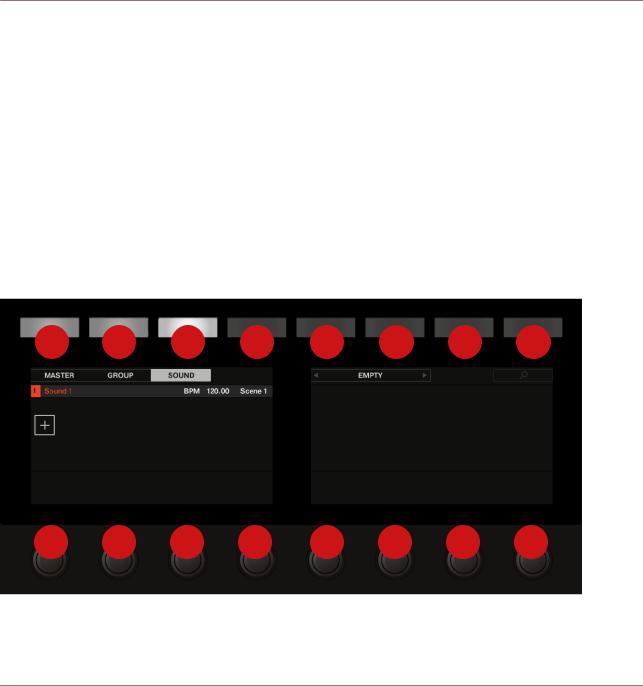
Welcome to MASCHINE
Documentation Overview
1.Press and hold SHIFT.
2.While holding SHIFT, press PLAY and release it.
3.Release SHIFT.
Displayed Products
Some images displayed in this document include products from the KOMPLETE and KOMPLETE ULTIMATE series. These products are not included with MASCHINE.
For more information on KOMPLETE and KOMPLETE ULTIMATE please visit the Native Instruments website.
Unlabeled Buttons and Knobs on the Controller
The buttons and knobs above and below the displays on your MASCHINE MK3 controller do not have labels (all other elements on the controller do).
1 |
2 |
3 |
4 |
5 |
6 |
7 |
8 |
1 |
2 |
3 |
4 |
5 |
6 |
7 |
8 |
The unlabeled buttons and knobs on the MASCHINE MK3 controller.
MASCHINE - Getting Started - 15

Welcome to MASCHINE
Documentation Overview
For better reference, we applied a special formatting here: throughout the document, the elements are capitalized and numbered, so the buttons are written Button (1–8), while the knobs are written Knob (1–8). For example, whenever you see an instruction such as “Press Button 2 to open the EDIT page,” you’ll know it’s the second button from the left above the displays.
MASCHINE - Getting Started - 16

Setting Up MASCHINE
Connecting the Controller to the Computer
2Setting Up MASCHINE
This chapter provides basic setup information and guides you through the process of integrating MASCHINE into your studio.
The MASCHINE software is installed both as a stand-alons application as well as a VST, Audio Unit, and AAX plug-in.
The MASCHINE stand-alone application must be opened once before using the plug-in within your DAW for the first time, after every upgrade, and after installing new MASCHINE EXPANSIONS.
The MASCHINE stand-alone application directly communicates with your audio and MIDI interfaces, which you can configure in the MASCHINE Preferences as described later in this chapter (see ↑2.2, Basic Audio Configuration). When MASCHINE is used as a plug-in within a host, the communication with your audio and MIDI interfaces is managed by the host.
For details about the audio and MIDI configuration of your host, and how to load plug-ins, please refer to its documentation.
2.1Connecting the Controller to the Computer
To connect the MASCHINE controller to your computer:
1.Attach the “device end” of the included USB cable to the USB socket on the rear panel of the controller.
MASCHINE - Getting Started - 17

Setting Up MASCHINE
Basic Audio Configuration
2.Attach the “computer end” of the USB cable to an available USB 2.0 (or later) port on your computer.
3.Press the power switch on the rear panel of the controller to switch it on.
→The controller is now detected by the operating system.
2.2Basic Audio Configuration
In this section, we describe the few steps required to make use of the MASCHINE controller’s integrated audio interface in various situations: with the MASCHINE software, with other music software, and within your operating system.
MASCHINE - Getting Started - 18

Setting Up MASCHINE
Basic Audio Configuration
2.2.1Using Your Controller as Audio Device in the MASCHINE Software
By default, when you launch the MASCHINE software as a stand-alone application it already uses your MASCHINE controller as audio input/output device, so you shouldn’t have to set up anything particular to have it work.
If this is not the case, e.g., if you have already changed the audio configuration in the MASCHINE software or if you want to use more advanced input or output routings, please proceed as follows:
1.In the MASCHINE menu click File > Preferences… to open the Preferences:
MASCHINE - Getting Started - 19

Setting Up MASCHINE
Basic Audio Configuration
2.Click Audio to display the Audio page:
MASCHINE - Getting Started - 20

Setting Up MASCHINE
Basic Audio Configuration
3.Select the hardware driver supported by your controller (e.g., ASIO on Windows) from the Driver drop-down menu.
4.Select Maschine MK3 from the Device drop-down menu.
5.In the Routings section, click Input and select 1: Input Left and 2: Input Right in the Maschine In 1 L and Maschine In 1 R drop-down menus, respectively.
This assigns the LINE IN / MIC IN combo inputs on your controller to the first pair of virtual inputs in the MASCHINE software.
6.In the same Routings section, click Output and select the left and right output channels of your controller you want to use for the various virtual outputs of the MASCHINE software.
→The MASCHINE software is now configured for using the internal audio interface of your MASCHINE controller.
By default, the virtual outputs of the MASCHINE software are assigned as follows:
▪The Maschine Out 1 L and Maschine Out 1 R virtual outputs are sent to the 1: Main Left and 2: Main Right outputs, which correspond to the LINE OUT L and R sockets on the rear panel of your controller, respectively.
▪The Maschine Out 2 L and Maschine Out 2 R virtual outputs are sent to the 3: Headphone Left and 4: Headphone Right outputs, which both correspond to the PHONES stereo socket on the rear panel of your controller.
2.2.2Selecting the MASCHINE Controller as Audio Device in Other Music Software
Before using the MASCHINE controller with music production software, you will need to set it up as the software’s audio output device. Most music production programs provide direct access to the soundcard properties in the audio and MIDI setup section of their preferences dialog. Please refer to the documentation of your music production software for more information on how to configure audio interfaces.
MASCHINE - Getting Started - 21

Setting Up MASCHINE
Basic Audio Configuration
2.2.3Selecting the MASCHINE Controller as Default Audio Output Device in Your Operating System
You can make your MASCHINE controller operate as your computer’s default soundcard. By doing this, you will send all audio coming from your operating system (e.g., system sounds, media player, etc.) to the desired output on the rear panel of your controller.
2.2.3.1On Windows
1. Open Start > Control Panel > Hardware and Sound > Sound.
2.In the Sound control panel, select the Playback tab.
3.In the list of available output devices, click the entry corresponding to the pair of outputs on your MASCHINE controller that you want to set as default: In the list, your controller appears as Maschine MK3 WDM Audio, and the available entries Main and Headphone correspond to the LINE OUT and PHONES sockets on the rear panel of your controller, respectively.
4.Click Set Default.
5.Click OK to confirm your selection and close the window.
→Your MASCHINE controller is now selected as the default audio output device.
2.2.3.2On macOS
1.Open the System Preferences under the gray Apple Icon menu in the top left corner of your screen.
2.Below Hardware (second row from top), select Sound.
3.In the Sound control panel, select the Output tab.
4.Select Maschine MK3 from the list of available soundcards.
5.Close the panel.
→Your MASCHINE controller is now selected as the default audio output device.
MASCHINE - Getting Started - 22

Setting Up MASCHINE
Setup Examples
2.3Setup Examples
In this section, you will learn how to connect the MASCHINE controller in various setup scenarios. Although we cannot cover all imaginable setups here, the examples are general enough to apply the information to most situations.
2.3.1Connecting Active Monitor Speakers
This example shows an all-in-one production system setup in which your active monitor speakers are directly plugged into your MASCHINE controller’s main outputs.
MASCHINE setup with active monitors.
To use active speakers (self-powered speakers with a built-in amplifier) with your MASCHINE controller:
MASCHINE - Getting Started - 23

Setting Up MASCHINE
Setup Examples
1.Turn the LINE OUT VOLUME knob on the rear panel of the MASCHINE controller to the left-end stop to set the output volume to minimum.
2.Connect the LINE OUT L/R sockets on the rear panel of the MASCHINE controller to your active speakers using balanced cables with 1/4" TRS jack plugs. First, connect the L output channel with the left speaker, then the R output channel with the right speaker.
3.Once you have connected the speakers to the device, set the volume knob on your active speakers to 0 dB and turn them on.
4.Start the playback of a Project in MASCHINE or an audio file on your computer.
5.Gradually turn the LINE OUT VOLUME knob on the rear panel of the MASCHINE controller until you reach an appropriate listening level.
If you have a main mixer connected to your monitors, and various devices plugged into your main mixer, you can simply add the MASCHINE controller to your setup by connecting its audio outputs to any stereo line input on your main mixer. Just follow the instructions above and replace the monitors’ volume knob with the volume fader of the input channel on your mixer to which you want to connect the MASCHINE controller.
MASCHINE - Getting Started - 24

Setting Up MASCHINE
Setup Examples
2.3.2Connecting Headphones
This example shows a setup for “on-the-road” beat making or performance including laptop, MASCHINE controller and a pair of headphones.
MASCHINE setup with headphones.
To use headphones with your MASCHINE controller:
1.Turn the PHONES VOLUME knob on the rear panel of the MASCHINE controller to the left-end stop to set the headphones volume to minimum.
MASCHINE - Getting Started - 25
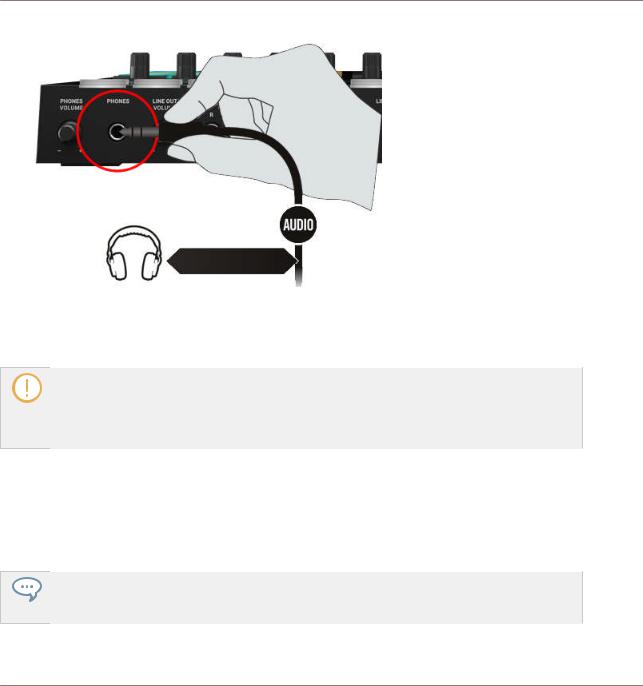
Setting Up MASCHINE
Setup Examples
2.Plug the 1/4" TRS jack of your headphones into the PHONES socket nearby.
3.Start the playback of a Project in MASCHINE or an audio file on your computer.
4.Gradually turn the PHONES VOLUME knob on the MASCHINE controller until you reach a comfortable listening level.
The headphones output of your MASCHINE controller is an additional stereo output, distinct from the main output pair, and perfectly tailored for the Cue channel of MASCHINE. However, if you want to monitor the main outputs in your headphones, please check the Route Main to Headphones box in the Audio Outputs section of the Hardware page in the Preferences. For more information, please refer to the Manual.
2.3.3MASCHINE in a Recording Setup
The following instructions will assist you in using the MASCHINE controller in a recording situation for capturing audio to MASCHINE — for example, for recording samples or process a live input during a performance.
You will find two examples using a recording setup with step-by-step instructions on how to route external audio to a particular Sound of your MASCHINE Project in section Using an External Sound Source and How to Sample.
MASCHINE - Getting Started - 26
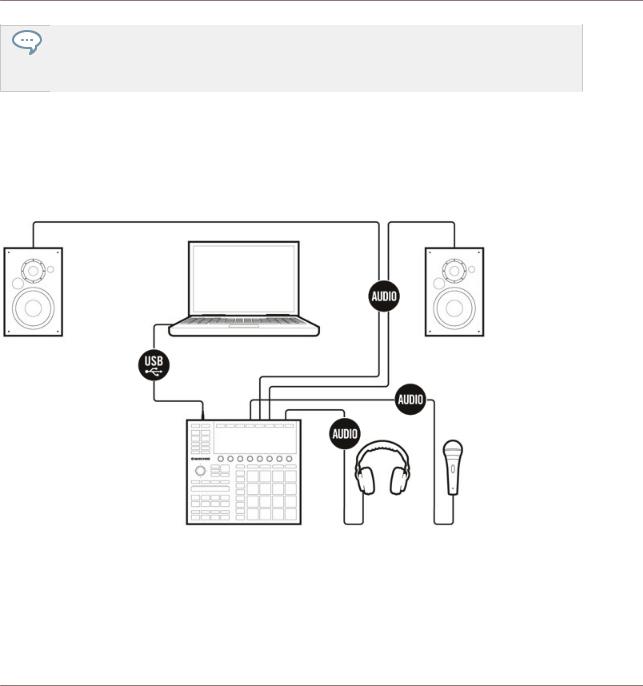
Setting Up MASCHINE
Setup Examples
You can use the described setups with MASCHINE as well as with any other music software running on your computer. For the audio device configuration required on the software side, see --- MISSING LINK --- or ↑2.2.2, Selecting the MASCHINE Controller as Audio Device in Other Music Software, respectively.
2.3.3.1Connecting a Dynamic Microphone
This example shows a setup with both a pair of active speakers (see ↑2.3.1, Connecting Active Monitor Speakers) and a pair of headphones (see ↑2.3.2, Connecting Headphones) with an extra dynamic microphone, e.g., for working with voice.
MASCHINE setup with a dynamic microphone.
MASCHINE - Getting Started - 27
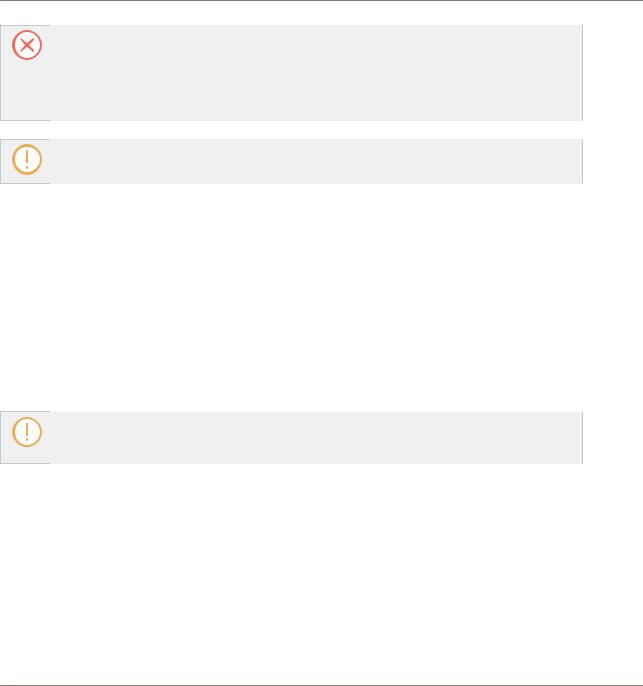
Setting Up MASCHINE
Setup Examples
Make sure the MASCHINE controller’s LINE OUT VOLUME, PHONES VOLUME, and MIC IN GAIN knobs are turned down before connecting a microphone to the MASCHINE controller. Microphones nearby speakers can cause a loud squealing tone from the speakers (a phenomenon called the “Larsen effect” or “audio feedback loop”) and can seriously damage your hearing and your equipment. The greater the distance between a microphone and speakers means this effect is less likely to occur.
You cannot plug a condenser microphone into the MASCHINE controller.
To use the MASCHINE controller in a recording setup with a dynamic microphone:
1.Turn the LINE OUT VOLUME, PHONES VOLUME and MIC IN GAIN knobs on the rear panel of the MASCHINE controller to the left-end stop to set the output volume, headphones volume, and microphone input level to minimum.
2.Plug the 1/4" TRS jack of your dynamic microphone into the MIC IN socket on the rear panel of your MASCHINE controller.
3.Turn the LINE OUT VOLUME and PHONES VOLUME knobs back to their usual levels.
4.While singing / playing an instrument into the microphone, adjust the input signal level by gradually turning the MIC IN GAIN knob clockwise while checking that the signal is not clipping.
When a microphone is plugged in the MIC IN socket, the LINE IN 1 and 2 sockets are bypassed. Hence, if you want to record the audio from a line level device, make sure that no microphone is connected to the MIC IN socket!
2.3.3.2Connecting Line Level Equipment (Synthesizer / Computer / Mixer Line Out)
This example shows a setup with both a pair of active speakers (see ↑2.3.1, Connecting Active Monitor Speakers) and a pair of headphones (see ↑2.3.2, Connecting Headphones) with an extra line level input device, e.g., a synthesizer.
MASCHINE - Getting Started - 28

Setting Up MASCHINE
Setup Examples
MASCHINE setup with a line level device (here a synthesizer) as input.
To use the MASCHINE controller in a setup with typical line level equipment:
1.Turn the LINE OUT VOLUME and PHONES VOLUME knobs on the rear panel of the MASCHINE controller to the left-end stop to set the output and headphones volumes to minimum.
2.Plug a pair of 1/4" TRS jacks from the outputs of your device into the LINE IN 1 and 2 sockets on the rear panel of the MASCHINE controller (use a single jack plugged into the LINE IN 1 socket if you are using a mono device).
3.Adjust the output signal of your connected device by using its relevant volume/gain control. Check that your input signal does not clip.
4.Turn the LINE OUT VOLUME and PHONES VOLUME knobs back to their usual levels.
MASCHINE - Getting Started - 29
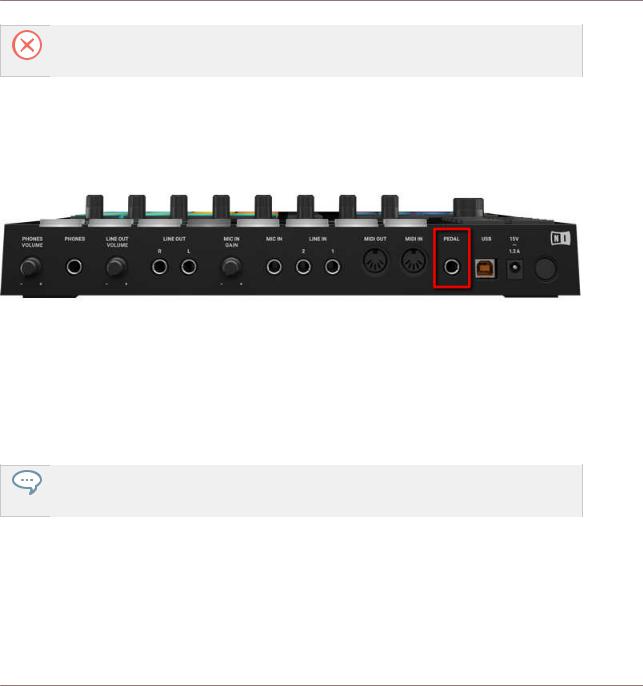
Setting Up MASCHINE
Setup Examples
In order to use the LINE IN 1 and 2 sockets on your MASCHINE controller, please make sure that no microphone is connected to the MIC IN socket nearby! Indeed, plugging a microphone into the MIC IN socket bypasses the LINE IN 1 and 2 sockets.
2.3.4Connecting a Pedal
Your MASCHINE MK3 Controller provides a pedal input in the form of 1/4" socket on its rear panel.
The PEDAL socket on the rear panel of your controller.
The PEDAL socket allows you to use a pedal footswitch to control the transport in MASCHINE. A single footswitch with two pedals can be used to control the transport in the following way:
▪Pedal 1: Starts/stop the playback in MASCHINE. This is equivalent to the PLAY button on your controller and the Play button in the software’s Header.
▪Pedal 2: Engage/disengage recording in MASCHINE. This is equivalent to the REC button on your controller and the Record button in the software’s Header.
The PEDAL socket can also be configured to send Continuous MIDI CC messages in the Preferences of the Controller Editor software. For more information read the MASCHINE MK3 chapter of the Controller Editor manual.
2.3.5Connecting External MIDI Equipment
The MASCHINE controller has dedicated MIDI sockets that allow you to directly connect other MIDI devices using a MIDI cable with a 5-pin DIN MIDI jack and integrate the controller into your MIDI setup.
MASCHINE - Getting Started - 30
